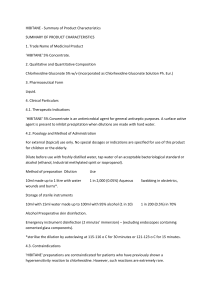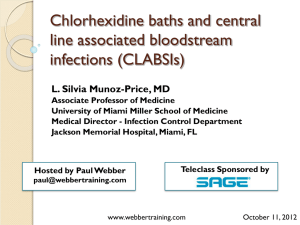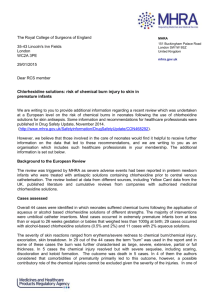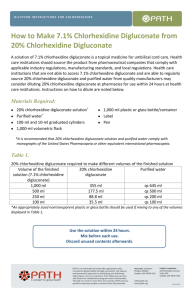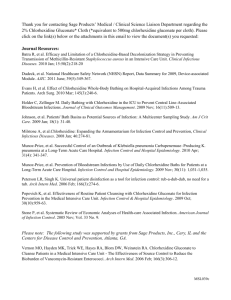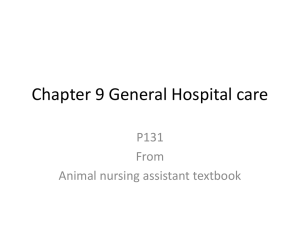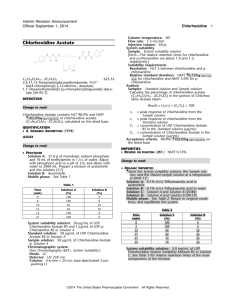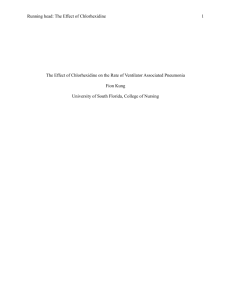HIBISCRUB - Summary of Product Characteristics SUMMARY OF
advertisement
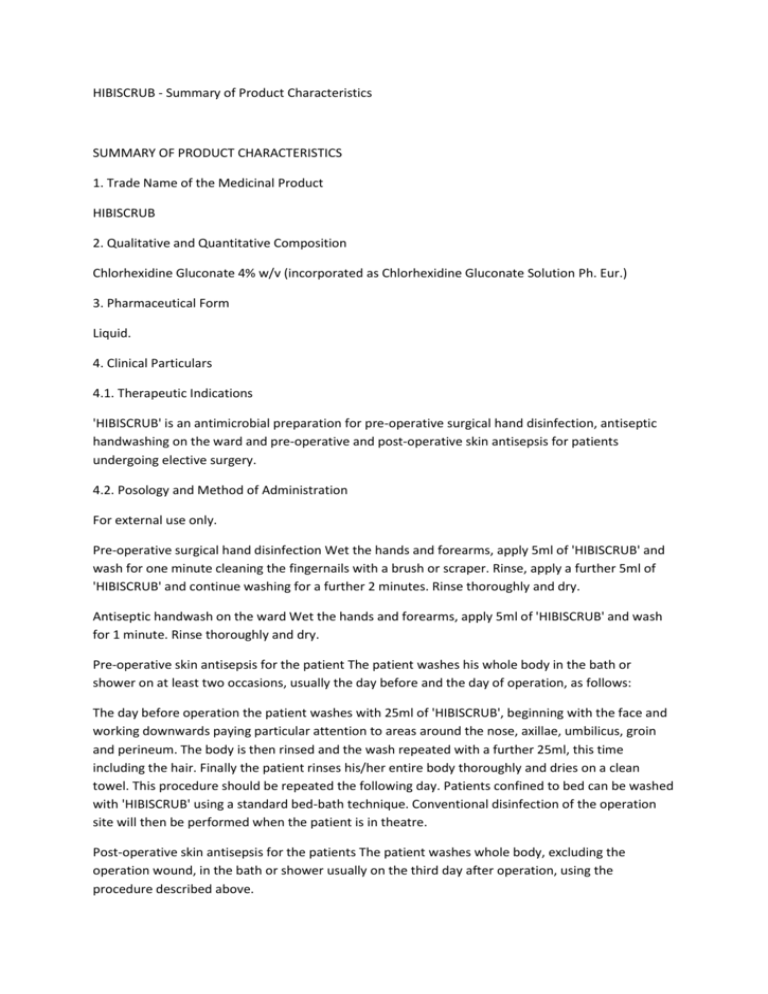
HIBISCRUB - Summary of Product Characteristics SUMMARY OF PRODUCT CHARACTERISTICS 1. Trade Name of the Medicinal Product HIBISCRUB 2. Qualitative and Quantitative Composition Chlorhexidine Gluconate 4% w/v (incorporated as Chlorhexidine Gluconate Solution Ph. Eur.) 3. Pharmaceutical Form Liquid. 4. Clinical Particulars 4.1. Therapeutic Indications 'HIBISCRUB' is an antimicrobial preparation for pre-operative surgical hand disinfection, antiseptic handwashing on the ward and pre-operative and post-operative skin antisepsis for patients undergoing elective surgery. 4.2. Posology and Method of Administration For external use only. Pre-operative surgical hand disinfection Wet the hands and forearms, apply 5ml of 'HIBISCRUB' and wash for one minute cleaning the fingernails with a brush or scraper. Rinse, apply a further 5ml of 'HIBISCRUB' and continue washing for a further 2 minutes. Rinse thoroughly and dry. Antiseptic handwash on the ward Wet the hands and forearms, apply 5ml of 'HIBISCRUB' and wash for 1 minute. Rinse thoroughly and dry. Pre-operative skin antisepsis for the patient The patient washes his whole body in the bath or shower on at least two occasions, usually the day before and the day of operation, as follows: The day before operation the patient washes with 25ml of 'HIBISCRUB', beginning with the face and working downwards paying particular attention to areas around the nose, axillae, umbilicus, groin and perineum. The body is then rinsed and the wash repeated with a further 25ml, this time including the hair. Finally the patient rinses his/her entire body thoroughly and dries on a clean towel. This procedure should be repeated the following day. Patients confined to bed can be washed with 'HIBISCRUB' using a standard bed-bath technique. Conventional disinfection of the operation site will then be performed when the patient is in theatre. Post-operative skin antisepsis for the patients The patient washes whole body, excluding the operation wound, in the bath or shower usually on the third day after operation, using the procedure described above. Children and elderly patients There are no special dosage recommendations for either elderly patients or children. The normal adult dose is appropriate unless recommended by the physician. 4.3. Contraindications 'HIBISCRUB' preparations are contraindicated for patients who have previously shown a hypersensitivity reaction to chlorhexidine. However, such reactions are extremely rare. 4.4. Special Warnings and Special Precautions for Use For external use only. Keep out of the eyes and avoid contact with the brain, meninges and middle ear. In patients with head or spinal injuries or perforated ear drum, the benefit of use in preoperative preparation should be evaluated against the risk of contact. If chlorhexidine solutions come into contact with the eyes, wash out promptly and thoroughly with water. Do not inject or use in body cavities. 4.5. Interactions with other Medicinal Products and other Forms of Interaction See section 6.2. 4.6. Pregnancy and Lactation There is no evidence of any adverse effects on the foetus arising from the use of ‘HIBISCRUB' as a handwash during pregnancy and lactation. Therefore no special precautions are recommended. 4.7. Effects on Ability to Drive and Use Machines None have been reported or are known. 4.8. Undesirable Effects Irritative skin reactions to chlorhexidine preparations can occasionally occur. Generalised allergic reactions to chlorhexidine have also been reported but are extremely rare. 4.9. Overdose This has not been reported. Accidental ingestion Chlorhexidine taken orally is poorly absorbed. Treat with gastric lavage using milk, raw egg, gelatin or mild soap. Employ supportive measures as appropriate. 5. Pharmacological Properties 5.1. Pharmacodynamic Properties Mode of action - chlorhexidine has a wide range of antimicrobial activity. Chlorhexidine is effective against a wide range of gram-negative and gram-positive vegetative bacteria, yeasts, dermatophyte fungi and lipophilic viruses. It is inactive against bacterial spores except at elevated temperatures. Because of its cationic nature, chlorhexidine binds strongly to skin, mucosa and other tissues and is thus very poorly absorbed. No detectable blood levels have been found in man following oral use and percutaneous absorption, if it occurs at all, is insignificant. 5.2. Pharmacokinetic Properties Retention and uptake kinetics and factors influencing the pharmacokinetics. Chlorhexidine appears to be very poorly absorbed. No blood levels were detected during a 3-week simulated clinical use of ‘HIBISCRUB'. 5.3. Pre-clinical Safety Data Chlorhexidine is a drug on which extensive clinical experience has been obtained. All relevant information for the prescriber is provided elsewhere in the Summary of Product Characteristics. 6. Pharmaceutical Particulars 6.1 List of Excipients D-glucono-delta-lactone Isopropyl alcohol Lauryl dimethyl amine oxide Perfume (herbacol 015393 TB) Polyoxyethylene-polyoxypropylene block copolymer Ponceau 4R (E124) Sodium hydroxide Glycerol Macrogol-7 Glycerol Cocoate Purified water 6.2. Incompatibilities Chlorhexidine is incompatible with soap and other anionic agents. Hypochlorite bleaches may cause brown stains to develop in fabrics which have previously been in contact with preparations containing chlorhexidine. 6.3. Shelf Life 36 months. 6.4. Special Precautions for Storage Do not store above 25 o C. 6.5. Nature and Contents of Container HDPE bottles containing 250ml, 500ml and 5 litres. 6.6. Instruction for Use, Handling and Disposal See section 4.4. 7. Marketing Authorisation Holder Regent Medical Overseas Limited, Two Omega Drive, River Bend Technology Centre Irlam Manchester M44 5BJ United Kingdom. 8. Marketing Authorisation Number PL 21855/0002 9. Date of First Authorisation/Renewal of Authorisation 30th December 2004. 10. Date of (Partial) Revision of the Text 30th December 2004

